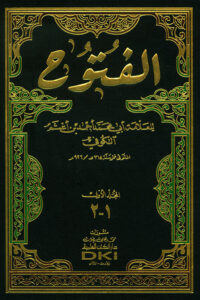Zaydī rebellion in the Kitāb al-Futūḥ of Ibn Aʿtham (fl. around 320/932): The case of Yaḥyā b. Zayd b. ʿAlī (d. 125/743)
Why Yaḥyā and why Ibn Aʿtham?
Rebellion was an integral feature of the early Islamic period, especially during the ‘long 8th century CE’. Among the numerous revolts conducted in the name of the ʿAlids, many have been associated with the ‘Zaydiyya’. At this early point in time, ‘Zaydiyya’ did not yet designate a (proto-)Shīʿī religious subdivision, but rather a socio-political group emerging from the rebellion of Zayd b. ʿAlī (d. 120-1/740), a descendant of al-Ḥusayn b. ʿAlī, in Kufa in 120-1/740.
The only son of Zayd’s who participated in this uprising, and who later led a revolt of his own in Khurasan, was Yaḥyā b. Zayd. Yaḥyā’s revolt remains understudied even though the Islamic tradition discusses it at some length. In a forthcoming article, I attempt to shed more light on Yaḥyā and his activities after his father’s death. In that context, I encountered intriguing differences in Ibn Aʿthams’ depiction of Yaḥyā’s revolt compared to a broad selection of Zaydī and non-Zaydī historical works (including al-Balādhurī, al-Yaʿqūbī, al-Ṭabarī, al-Iṣfahānī, al-Nātiq bi-l-Ḥaqq, Gardīzī, and al-Muḥallī, among others). I plan to write up an article on these differences in the future but want to present some initial observations in what follows. This is important for two reasons: Ibn Aʿtham’s work remains underutilised in the study of (Zaydī) rebellion and thus can offer new data. It also appears that Ibn Aʿtham took a special interest in rebellion more generally, an issue that awaits further research. I will touch on both these points, starting with his account of Yaḥyā’s revolt.
Yaḥyā’s revolt in the Kitāb al-Futūḥ: flight, imprisonment, bayʿa
The story of Yaḥyā b. Zayd’s revolt began in Kufa, whence he fled to Khurasan with some of his father’s surviving supporters. There, he hid in various places until he was captured by the Umayyads in Balkh and imprisoned in the provincial capital, Marw. After his release from prison, he travelled westwards. At some point, probably in Bayhaq, the western-most district of Khurasan, Yaḥyā decided to return to Nishapur, where he fought his first battle against Umayyad forces. Afterwards, he continued to Jūzjān, where he was eventually killed in another battle.
Ibn Aʿtham’s narrative of Yaḥyā’s revolt includes most of the core elements featuring in other sources. However, his account differs concerning several aspects; three of the most important shall be briefly discussed here.
Yaḥyā's flight
Ibn Aʿtham provides a different sequence of events and locations regarding Yaḥyā’s flight to Khurasan. In comparison to, e.g., al-Yaʿqūbī or al-Masʿūdī, Ibn Aʿtham names many more people who supported and sheltered him along the way, and also gives a different location for Yaḥyā’s eventual capture in Balkh. Most significantly, however, Ibn Aʿtham refers to two Umayyad officials who helped Yaḥyā during his flight. The first such incident took place in al-Madāʾin, when its Umayyad ʿāmil (governor) informed Yaḥyā that he was wanted by the caliphal authorities and gave him money to facilitate his escape. The second occurred when Yaḥyā’s attempt to disguise himself amongst his followers in Marw failed: the Umayyad agent sent after him discovered him eventually but told Yaḥyā to leave quickly and let him escape.
Release from prison
Yaḥyā was eventually captured in Balkh, brought to Marw and imprisoned there. However, he was soon released when al-Walīd b. Yazīd (r. 125-6/743-4) assumed the caliphate and ordered Yaḥyā to be freed from prison. The reasons for Yaḥyā’s release are not quite clear; I have argued in a forthcoming article that his amnesty was bound to al-Walīd’s attempt to secure the bayʿa (pledge of allegiance) for himself. Ibn Aʿtham’s narrative supports this interpretation: he places Yaḥyā’s release after a detailed account of al-Walīd’s bayʿa. Ibn Aʿtham also has Yaḥyā’s explicitly promise not to disobey (ʿaṣā) the governor, the caliph, and their orders. In other sources, his obedience is either only implied or – contrarily – his opposition foreshadowed by having him insult the Umayyads as the ‘greatest fitna’.
Yaḥyā's bayʿa
After his release from prison, Yaḥyā’s followers joined him and pledged their loyalty to him. The bayʿa was a powerful and prolific tool used by caliphs and rebels alike. While Ibn Aʿtham repeatedly refers to people and groups who followed Yaḥyā, there is only one direct reference to the bayʿa: Yaḥyā reportedly proclaimed to the people of Jūzjān that he was a descendant of ʿAlī and Fāṭima to secure their pledge. Theoretically, the bayʿa as a reciprocal covenant between leader and followers could not to be dissolved. In Ibn Aʿtham’s narrative, however, Yaḥyā offered to release his followers from their pledge before the final battle because of their desperate situation. No other source mentions this and – of course – Yaḥyā’s followers turned down his offer. In contrast, the Maṣābīḥ and the Ḥadāʾiq, both Zaydī works, relate that Yaḥyā prepared his followers for martyrdom shortly before his first battle against the Umayyad governor of Nishapur.

How to explain these differences?
A comprehensive discussion of Ibn Aʿtham’s work is not feasible here. In what follows, I will therefore put forward some tentative suggestions as to how we might explain Ibn Aʿtham’s unique perspective.
Previous research has shed some light on Ibn Aʿtham’s life, his scholarly connections, and his sources. First, Ibn Aʿtham had personal ties to Khurasan, where Yaḥyā had rebelled. The earliest extant biographical entry on Ibn Aʿtham, who was an Azdī from Kufa, is included in al-Sahmī‘s (d. 427/1035) Taʾrīkh Jurjān, a biographical work on ḥadīth transmitters who lived in or visited Jurjān. Ibn Aʿtham reportedly stayed there for some time and taught the local muḥaddith Ibn ʿAdī (d. 365/976). He also reportedly met al-Sallāmī (d. after 350/961?), a famous historian from Bayhaq and author of a lost Arabic history of the rulers of Khurasan. Ibn Aʿtham’s work is furthermore mentioned in Ibn Funduq’s (d. 565/1169) mostly lost Tārīkh-i Bayhaqī, another connection to the province and city that played a central role in Yaḥyā’s revolt. Finally, the historian al-Madāʾinī (d. c.228/843?), known as an authority on Iran and Transoxiana, was also a key source for Ibn Aʿtham. Taken together, this evidence suggests that Ibn Aʿtham had access to local Khurasanī knowledge and that he was considered an authority in the Islamic east in particular. This sets his history apart from other contemporary works, at least in what concerns the narrative of Yaḥyā’s revolt; it remains to be seen whether this also applies to other Zaydī/proto-Shīʿī revolts.
Second, both pre-modern historians and contemporary Islamicists have referred to Ibn Aʿtham’s (pro-)Shīʿī leanings. This is connected to the fact that Ibn Aʿtham originated from or lived in Kufa, one of the centres of (proto-)Shīʿism, and that some of his sources, like al-Madāʾinī and Abū Mikhnaf, are themselves referred to as (proto-)Shīʿīs. It has also been argued that Ibn Aʿtham might have had access to Kufān Zaydī material, and that his Futūḥ presents events from a Shīʿī point of view, e.g., by according ʿAlī b. Abī Ṭālib a special place among his contemporaries. Finally, it seems that Ibn Aʿtham was particularly interested in the maqātil genre, i.e. material dealing with the killing of notable historical personalities (especially the ʿAlids).
Conclusion
The discussion above shows that Ibn Aʿtham’s Futūḥ includes insightful additional material regarding Yaḥyā b. Zayd’s revolt. While this material might not profoundly challenge our understanding of Yaḥyā and his revolt, it certainly adds another layer to Yaḥyā’s narrative. Ibn Aʿtham’s unique accounts, such as Umayyad officials helping Yaḥyā on his flight, seem to cast the narrative in a more nuanced light. It is to be assumed that much of this additional material reflects Ibn Aʿtham’s access to local, Khurasanī knowledge – a hypothesis to be tested against his accounts of other (Shīʿī/ʿAlid) events taking place in the region. These aspects have a historical and historiographical importance that needs further study
More generally speaking, it is an urgent desideratum to include Ibn Aʿtham’s Futūḥ more thoroughly in future study of Zaydī and pro-ʿAlid rebellion. For one thing, both the Khurasanī and the Kufan contexts are particularly relevant for the development of the Zaydiyya from a seemingly loose group of pro-ʿAlid rebels to an independent branch of Shīʿī Islam. For another, as Andrew McLaren’s recent dissertation has shown, Ibn Aʿtham’s treatment of Zaydī rebellion seems peculiar: while his account of Zayd b. ʿAlī’s revolt might even suggest that Ibn Aʿtham held Zaydī views, the famous Fakhkh Revolt of 169/786 – perceived as one of the most decisive turning points in the development of Zaydism – is not mentioned at all. His account of Yaḥyā does not betray an explicitly (pro-)Shīʿī perspective and differs from the depiction of other ‘Shīʿī’ authors, e.g., al-Yaʿqūbī and al-Masʿūdī. However, his clear focus on Yaḥyā’s character and activities is something his work shares with al-Iṣfahānī and the Zaydī sources. This once more raises the question of what a ‘Shīʿī’ historiographical perspective actually entails. Nevertheless, engagement with Ibn Aʿtham’s Futūh promises to contribute to a more nuanced picture of (at least some) Zaydī revolts as understudied historical events, as well as to a better understanding of Ibn Aʿtham’s material and approach.
Further reading
Haider, Najam (2011). The Origins of the Shīʿa. Identity, Ritual, and Sacred Space in Eighth-Century Kūfa (Cambridge Studies in Islamic Civilization). Cambridge: CUP.
Kontny-Wendt, Natalie (forthcoming). “The Revolt of Yaḥyā b. Zayd b. ʿAlī (d. 125/743) in Khurāsān – Bayʿa, Disobedience, and Rebellion in the Early Islamic Period.” Rebels and Rulers in the Early Islamicate World: Power, Contention and Identity, ed. by H.-L. Hagemann and A. Grant, Edinburgh: EUP.
Lindstedt, Ilkka (2017). “Sources for the Biography of the Historian Ibn Aʿtham al-Kūfī.” Contacts and Interaction. Proceedings of the 27th Congress of the Union Européenne des Arabisants et Islamisants, ed. by J. Hämeen-Anttila, P. Koskikallio, and I. Lindstedt (Orientalia Lovaniensia Analecta, 254), Leuven: Peeters, 299–309.
Madelung, Wilferd (2002). “Yaḥyā b. Zayd.” Encyclopaedia of Islam. New Edition (EI²), vol. 11, Leiden: Brill, 249–50.
McLaren, Andrew G. (2023). Ibn Aʿtham’s History: Transmission and Translation in Islamicate Written Culture, 290-873/902-1468 (unpublished PhD dissertation, Columbia University).
Natalie Kontny-Wendt is a doctoral researcher in the Emmy Noether project “Social Contexts of Rebellion in the Early Islamic Period (SCORE)” led by Dr Hannah-Lena Hagemann and hosted at the Universität Hamburg. Her dissertation focusses on the supporter networks of a series of pro-ʿAlid/Zaydī revolts between 740–820 CE. In addition, she is currently working on an article about the Kitāb al-Futūḥ’s representation of (Zaydī) rebellion.


